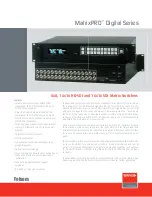
ipv6 address eui-64
60-7
60
Related Commands
ipv6 address (60-4)
show ipv6 interface (60-10)
ipv6 address eui-64
This command configures an IPv6 address for an interface using an EUI-64
interface ID in the low order 64 bits and enables IPv6 on the interface. Use the
no
form without any arguments to remove all manually configured IPv6 addresses from
the interface. Use the
no
form with a specific address to remove it from the interface.
Syntax
ipv6 address
ipv6-prefix
/
prefix-length
eui-64
no ipv6 address
[
ipv6-prefix
/
prefix-length
eui-64
]
•
ipv6-prefix
- The IPv6 network portion of the address assigned to the
interface. The prefix must be formatted according to RFC 2373 “IPv6
Addressing Architecture,” using 8 colon-separated 16-bit hexadecimal
values. One double colon may be used in the address to indicate the
appropriate number of zeros required to fill the undefined fields.
•
prefix-length
- A decimal value indicating how many contiguous bits (from
the left) of the address comprise the prefix (i.e., the network portion of the
address).
Default Setting
No IPv6 addresses are defined
Command Mode
Interface Configuration (VLAN)
Command Usage
• If a link local address has not yet been assigned to this interface, this
command will dynamically generate a global unicast address and a link-local
address for this interface. (The link-local address is made with an address
prefix of FE80 and a host portion based the switch’s MAC address in modified
EUI-64 format.)
• Note that the value specified in the ipv6-prefix may include some of the
high-order host bits if the specified prefix length is less than 64 bits. If the
specified prefix length exceeds 64 bits, then the network portion of the
address will take precedence over the interface identifier.
• If a duplicate address is detected, a warning message is sent to the console.
• IPv6 addresses are 16 bytes long, of which the bottom 8 bytes typically form
a unique host identifier based on the device’s MAC address. The EUI-64
specification is designed for devices that use an extended 8-byte MAC
address. For devices that still use a 6-byte MAC address (also known as
EUI-48 format), it must be converted into EUI-64 format by inverting the
Summary of Contents for Direk Tronik 24/48-Port
Page 2: ......
Page 4: ...ES4524D ES4548D F0 0 0 4 E112006 CS R01 149100030400A...
Page 22: ...xxii Tables...
Page 26: ...xxvi Figures...
Page 28: ...Getting Started...
Page 50: ...Initial Configuration 2 14 2...
Page 52: ...Switch Management Configuring Domain Name Service 29 1 Switch Clustering 30 1...
Page 68: ...Basic System Settings 4 8 4...
Page 118: ...Simple Network Management Protocol 11 18 11...
Page 142: ...Configuring 802 1X Port Authentication 14 8 14...
Page 154: ...Access Control Lists 15 12 15...
Page 232: ...Configuring Protocol Based VLANs 25 4 25...
Page 252: ...Quality of Service 27 8 27...
Page 282: ...Using the Command Line Interface 31 10 31...
Page 290: ...General Commands 33 6 33...
Page 300: ...System Management Commands 34 10 34...
Page 308: ...File Management Commands 35 8 35...
Page 326: ...Event Logging Commands 37 8 37...
Page 336: ...Time Commands 39 6 39...
Page 406: ...Access Control List Commands 44 18 44...
Page 418: ...Interface Commands 45 12 45...
Page 432: ...Broadcast Storm Control Commands 47 2 47...
Page 436: ...Rate Limit Commands 49 2 49...
Page 478: ...VLAN Commands 52 18 52...
Page 508: ...Quality of Service Commands 56 10 56...
Page 518: ...Multicast Filtering Commands 57 10 57...
Page 532: ...IPv4 Interface Commands 59 6 59...
Page 560: ...IPv6 Interface Commands 60 28 60...
Page 566: ...Switch Cluster Commands 61 6 61...
Page 568: ...Appendices...
Page 582: ...Glossary Glossary 8...
Page 587: ......
Page 588: ...ES4524D ES4548D E112006 CS R01 149100030400A...
















































